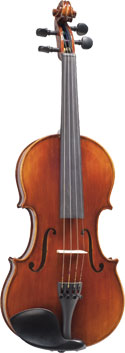 If you or your child is just starting out on the violin: congratulations! Welcome to the string community! If you’re looking for your first instrument, though, things can be confusing. Trying to find the best violin can be a bewildering path to take. Here are some guidelines that should help you along your journey!
If you or your child is just starting out on the violin: congratulations! Welcome to the string community! If you’re looking for your first instrument, though, things can be confusing. Trying to find the best violin can be a bewildering path to take. Here are some guidelines that should help you along your journey!
When you’re purchasing a violin for the first time, here are a few things to look for:
- Pegs: These must be made of real ebony, rosewood, or boxwood! Are they properly fitted so that they turn easily without slipping or sticking? If the instrument has pegs that keep slipping then it will be very difficult for the new violinist to attempt to play in tune. Many cheap violins (like the $99 specials sold in online marketplaces) have horrendous pegs that will not hold tension.
- Fingerboard: Is it real ebony or is it some other type of wood that’s been painted black? Violin makers have used ebony fittings for years because of the wood’s hardness, so if the fingerboard isn’t really ebony then it is much more likely to wear out, warp, crack, or splinter.
- Bridge: Is it the correct height? Too low and the strings will vibrate against the fingerboard; too high and the violin will be hard to play. Do the feet sit flush against the top of the instrument? If not, then the instrument’s potential is not being met. The bridge conveys the vibrations of the strings into the face of the violin, so if it’s not making contact with the wood then the vibrations are being lost. Some instruments sold online don't even come with a fitted bridge, or come with a bridge that you have to install yourself - this is a big red flag!
- Purfling: Is it real ebony inlaid into the wood or is it just painted on? The purfling is inlaid around the edges of the instrument in order to protect the wood from cracking and to allow the instrument to resonate freely for good volume and tone. If the instrument doesn’t have this inlay, then any sort of damage sustained to the edges of the violin is likely to spread into the face of the instrument, rendering it unplayable. (Again, the $99 e-shopper "violin-shaped-objects" are often missing this vital detail!)
- Wood: The top of a violin needs to be spruce and the back of it is almost always maple. The wood also needs to be properly aged; if it is varnished before the wood has aged properly then it is at risk of cracking or warping. (And you should see the wood! As alluring as a painted violin may be, it is usually a sure sign that the violin isn't proper wood, and that what you are buying is not a true musical instrument, but a toy... Only proper varnish can protect the instrument AND allow it to have a good sound!)
- Fine Tuners: Do they turn easily? Are they digging into the face of the instrument beneath the tailpiece? Built-in fine tuners like you get on Franz Hoffmann instruments are the standard for beginner and student-level instruments. But beware of the fine tuners on those online bargain-bin instruments - people constantly bring student instruments into our shop that need a new tailpiece because the fine tuners stopped working!
These are just a few things to look for. More often than not, if you purchase a violin from ebay, craigslist, other e-shopper sites, or even some music stores that don't specialize in strings, it probably won’t fit the bill. These instruments are what we like to call VSO’s (“Violin Shaped Objects”). The good news is that all of our student instruments at SHAR are made by our exclusive makers, and completed, set-up, and inspected here in our shop to make sure that they fit these and other precise specifications!
The other thing that you’ll need to know when you purchase your first instrument is what size to get. If you’re an adult then you’ll need a full size instrument. But if you’re getting the instrument for your child, then you’ll have to get some measurements! We think it’s best for the child’s teacher to size him or her, but this video contains some guidelines as well:
Finally, you’ll need more than just the instrument – you’ll need a case and a bow, too! If you buy an instrument from SHAR that comes with an outfit, then you are all set; an “outfit” includes the instrument, case, bow, and rosin.
If you have any other questions or concerns about purchasing your first violin, don’t hesitate to call us at 1.800.248.7427! We are happy to help you.



